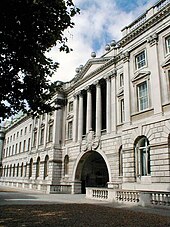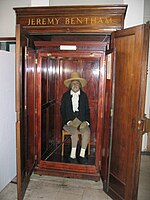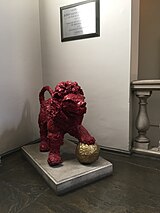King's College London–UCL rivalry
The rivalry between King's College London and University College London has been a part of London life for nearly two centuries.[1]
Origins
University College was founded with the backing of Jews, Utilitarians and non-Anglican Christians as a secular institution intended to educate "the youth of our middling rich people between the ages of 15 or 16 and 20 or later".
King's College, by contrast, was founded by royal charter for "the general education of youth in which the various branches of Literature and Science are intended to be taught, and also the doctrines and duties of Christianity [...] inculcated by the United Church of England and Ireland."[2] The College counted King George IV and then-Prime Minister the Duke of Wellington among other eminent politicians and theologians of the British Establishment as its early benefactors.[3][4][5]


Early in 1829, the Earl of Winchilsea publicly challenged Wellington about the Duke's simultaneous support for the Anglican King's College and the Roman Catholic Relief Act 1829. The result was the Wellington–Winchilsea duel at Battersea Fields on 21 March. Shots were fired but no-one was hurt. Duel Day is still celebrated annually at King's as a formal dinner and reenactment held in March.[6][7]
Student Rags
Student Rags were manifestations of the rivalry between the two institutions. Rags were "colourful, subversive, and occasionally dangerous" for both participants and bystanders and reached their height between the two World Wars.[8] A long-running campaign of the rags were the attempts to capture each other's mascots. Running battles were supposedly brought to an end by the colleges' authorities in the first half of the twentieth century, but rivalry amongst the two University of London colleges continues to this day.[9]

College mascots

The mascots of both universities were frequently kidnapped by students of the other.
In 1922, King's students—allegedly bitter about a rugby defeat—kidnapped Phineas, the large wooden highlander model that had served as UCL's unofficial mascot since 1900. After more than an hour of fighting and an eventual intervention by the Metropolitan Police, Phineas was returned to UCL with a broken arm.
Reggie the Lion has been the King's mascot since 1923. Reggie was captured by UCL students in 1927 and filled with rotten apples. That same year, King's and UCL students brawled in the UCL Main Quad following a failed kidnapping attempt. Six students were hospitalised and two arrested as a result of the incident.
Other incidents have included the tarring and feathering of Phineas and the burial of Reggie in Hampstead Heath. The affair culminated in 1989 with the infamous theft of Jeremy Bentham's mummified head by King's students, who reportedly played football with it and were threatened with fines and expulsion. Mascot theft has since died down with both universities' mascots under securely protection.[10][11][12]
Women
UCL was the first major university to admit women in the UK, reflecting another historical ideological difference with King's College.[13][14]
See also
References
- ^ Origins of the Colleges' Contrasting Histories, London: King's College London, retrieved 14 January 2013
- ^ "The University of London: The Constituent Colleges - British History Online". www.british-history.ac.uk.
- ^ "King's College London - Foundation of the College". www.kcl.ac.uk.
- ^ "The University of London: The Founding Colleges". www.victorianweb.org.
- ^ "King's College London and its archives relating to the long eighteenth century". 20 January 2017.
- ^ Duel Day Celebrations 2011, London: King's College London, retrieved 14 January 2013
- ^ Duel Day – Questions and Answers, London: King's College London, retrieved 14 January 2013
- ^ Mayhem in the Metropolis, King's College London, retrieved 14 January 2013
- ^ "Centre for Advancement of Women in Politics". Retrieved 23 November 2007.
- ^ "Phineas v Reggie: A rivalry for the ages | Students Union UCL".
- ^ "History of UCL: The essential prequel for incoming freshers". 13 August 2020.
- ^ "Strength to Strength: 1981 - 1993 | Feature from King's College London".
- ^ "The University of London: The Founding Colleges".
- ^ "Women and the Rag". Kings Collections. Retrieved 19 July 2023.

